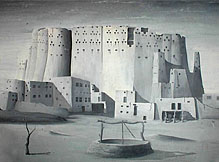 |
|
Banks
Good news for you. Do not worry about
the bank any more. there is a Bank in the Oasis now .It
located near the new police station Siwa Town. However, you needn’t
feel stranded. If you find yourself short of Egyptian
pounds, local shops and hotels will sometimes accept
US dollars at the current exchange rate.
|

A painting of ancient Shali
|
 |
Shali
Dominating the marketplace are the crumbling ruins of a 12th
century fortress known as Shali. Siwans built it for
protection from the hostile Bedouin tribes who periodically
raided the oasis. The walls and houses are constructed not
from mudbrick but karsheef, a stone made of sun-baked clay,
salt and fine sand which is dug from the edges of the salt
lakes. Built atop a limestone hill, the fortress was quite
solid and commanded a view of the open desert as well as the
thousands of palm and olive trees that spill forth. The
original fortress had three gates: the first, for the
“adjuwat” or notables; the second, for the women; and the
third for the general public. Inside the fortress walls was a
thriving village complete with streets and a well large enough
to satisfy its 700 inhabitants. Strangers were not allowed to
enter the village, and the fortress was closed after dark as a
safeguard against invaders.
After Mohammed Ali’s conquest of Siwa in
1840, the inhabitants slowly trickled down from the hill and
into the surrounding area, building the villages that continue
to grow today. Severe rainstorms in 1930, 1970 and 1985
destroyed many houses, forcing out most of the remaining
inhabitants and convincing them to abandon karsheef for cement
and white stone. As a result, the face of Siwa is changing
forever.

Juba Bath (Cleopatra Bath)
Another favourite bathing spot for locals and
tourists is Fatnas Island, located on the salt
lake of Birket Siwa, surrounded by palm trees and
beautiful scenery.
|
 |